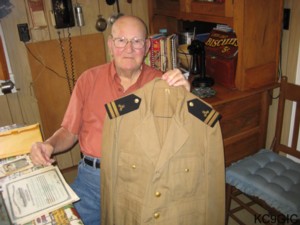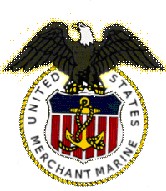
Interview with a Merchant Marine
Written By Jeremy
Schotter

*Logo courtesy of
Wikipedia
-History
The Merchant Marines have
been
active in all
American wars, from the Civil War to the current war in
Throughout WWII, being a mariner was one of the deadliest occupations, with a 1 in 24 death rate. Of the 215,000 who served, 8,651 perished onboard 733 cargo ships. Nonetheless, without the support of the Merchant Marines during the war, victory could not have been achieved. During peacetime, the Merchant Marines are responsible for transporting cargo and passengers, and can be called upon at any time for service in the military. In 1988, President Ronald Reagan signed a bill into law granting veterans status to those mariners who served during wartime. Prior to this bill they were considered civilians and did not receive veteran benefits.
-Interview with a former Mariner
In March of
2009 I had the opportunity and privilege to sit down and talk with
my
good
friend Robert (Bill)
When
I
arrived at Bill’s house, he was already flipping through a photo
album
that he
purchased in
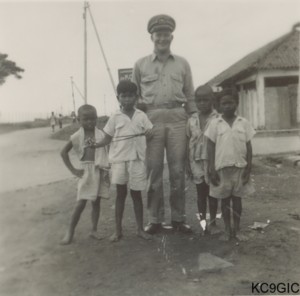
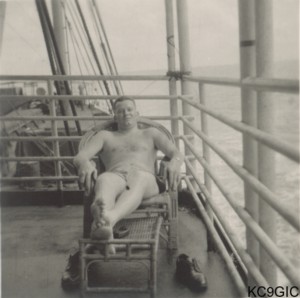
Left: Bill
with
children overseas. The children would run to men in uniform as
they
usually handed out candy. Right: Working hard or hardly
working?
Q:
How did you end up becoming a Merchant
Marine?
Bill: Well,
that’s interesting,
would be a good beginning. I worked at the K&I railroad, and
I was
a call
boy. A call boy would go out to the people (railroad
employees) who didn’t have telephones when you were
getting ready
to run a
train. If they lived within two miles of the railroad tracks
they
didn’t have
to have a telephone, and the ones that lived beyond two miles
had to
have one.
I’d call the crew and tell them what time they had to leave and
everything. I
worked in what they called the “callers office”.
A guy came there from the Merchant
Marine recruiting office. The railroad engineers were qualified
to be
engineers
on a ship, cause in those days all the locomotives were steam
powered
and the
ships were steam powered. So this recruiter came down there
trying to
talk some
of the railroaders into joining the Merchant Marines, cause they
needed
engineers.
Of coarse he was hanging out in the
office and I got to talking to him. At that time I was about 17
years
old and I
ask what kind of job they would have for me. Cause I said I was
going
to get
drafted when I turn 18 and he gave me allot of brochures and
all. The
recruiting office was in
Q: What kind of training did you have to go through?
Bill:
Well,
basically something that didn’t do us any good. All that
marching I
done,
carrying packs on my back and so forth, that was totally
useless. We’d
put 100
pound packs on our backs and walk 20 miles and stuff like
that. It was
totally
useless and had nothing to do with operating a ship. Of
course we had
classes,
so I decided to go into the engine department. I studied up
on the
engines,
maintaining them and so forth.
* Bill shows me the
back of his identification card that lists the jobs he was
qualified to
do..
I had deck engineer and junior
engineer. Those
were my qualifications I
done in
Q:
During
your training you had to learn to
swim through burning oil and water, can you tell me more about
that?
They
made
everyone learn to swim. Some of the guys absolutely couldn’t
swim;
they went ahead and passed them anyways. Part of the
training was if a
ship was
torpedoed, with the tremendous amount of oil onboard for
fuel since
they burnt
oil. So they taught us how to swim through burning oil. What
you do is
take you
hand likes this and throw it away from you and paddle
yourself by
kicking your
feet cause you gotta use your arms to keep the oil away from
you.
* Bill demonstrates
what he learned in training to swim through burning oil.
If you swim through it, it will close in behind you so you want to move along as fast as you can. They made us dive off of a real high dive cause it was about 50 feet from the bridge down to the water level on a ship. If you fall flat its likely bust your gut. You had to hit with your head or your feet, either one.
Q:
Did your ships ever come under attack?
No, I never got a scratch on me the
whole war.
While
going
through the Straight of
The
most
action I saw was in
-Encountering
Mines
The
only
time we were close (in reference to a mine in the water) was
when we got to
Q: Bill
talks about the different ships he served on and places he
went.
Bill:
The
first ship I was on was called the Freeman, it was owned by
the
Pocahontas Coal
Company in
When they paid us off you could
get off the ship, so I got off after one trip. Then I went
back to
I
was
qualified for 30 days leave by then so I got off the S.S.
Koolmotor
and came back to
When
I
came back I was qualified for more leave, so I took another
30
days. I went back on got on a
The
I got
on the Stephen Girard. We went down to
We
unloaded troops back in
I
got off
her when they paid us off and I came home for 30 days. Then
I
went back to
Then I got on a ship
called the Steel Worker, and I stayed on it about two years.
The Steel
Worker
was owned by the Isthmian Steam lines. In that two year
period I don’t
know how
many times we went around the world, I think around four or
five. We
would
leave
We’d start the process over. We’d go
down to
I
went on
the Steel Worker as a junior engineer, and when I got off I
was a second engineer. That was the best ship I was ever on,
and the
one I
enjoyed the most. I was what
they called
a crew member until I got off the Stephen Girard. You had to
have 18
months
service as a crew member, then you could take examinations
to be an
engineer.
When I turned 21 I took an examination pretty quick. I
passed the
examination
and I was a third engineer. Life was allot better after I
got to be an
engineer. I had my own living quarters and everything. It
paid a whole
lot
more. In fact it more than doubled my salary.
Q: Bill speaks of his last voyage on the Steel Worker and decision not to go back.
In 1949 I got off the Steel Worker and I
fully intended to go back but I had allot of leave built up.
I had
about 60
days leave. I came back to
I got tired of that so I wanted to
have a day job, so I got a job with a trucking company. I
worked from
eight in
the morning to about four or five in the afternoon. I think
that was in
1952.
By 1959 I had saved enough money to buy a farm. Met my wife
and married
her,
and have been in New
Q:
What were some of your experiences you
had while working on a ship?
-Encountering rough weather.
I remember one incident it got so rough
that in a 24 hour period we made 30 miles. The rougher the
water the
slower you
had to go, cause when you run fast and the bow dips down you
pick up
allot of
water. That water would come down the deck sometimes four
foot deep. If
you went
real slow, instead of the bow dipping under water it would
lift up.
It would get so rough that the
cooks couldn’t cook at all. They had kettles with real tall
sides, and
you
could only fill them half full. When it got real rough we
had to eat
soup until
the water calmed down. That was the only thing they could do
is make
soup.
The
main
thing was you just had to hold on to something when you
walked. After a bad storm like that you’d look down the
passageways and
there
would be footprints on the side of the wall. The ship would
lean so bad
you had
to put one foot up on the wall. There was a water tight door
to go
outside; if
it was that rough you didn’t dare go outside.
I
was on a
ship that took a 45 degree roll one time. That’s halfway to
being upside, but she rolled 45 degrees. A 40 degree roll
was pretty
common
place. When you got past that then it got scary.
- The
missionary
That
girl
was a missionary.
*Bill
points
to a girl in a photo.
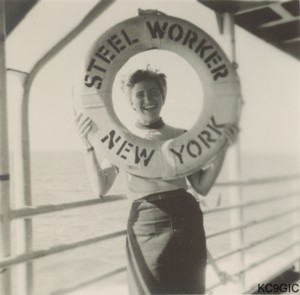
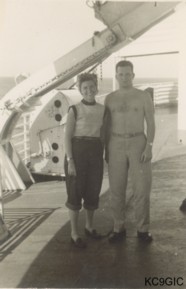
She was a passenger
who got on the ship in
She started down the gang plank,
stopped, and looked back up at me. I just waved to her
and let her go.
Anyways,
one of the guys said “
I’d
rather
have
*
We both laugh;
